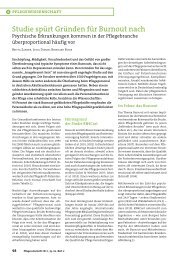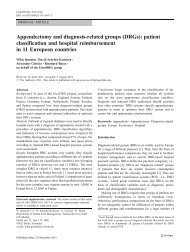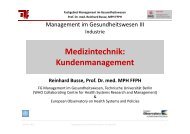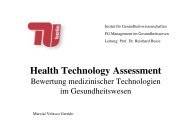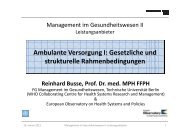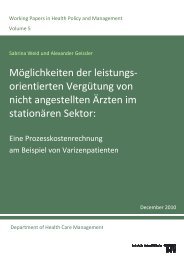The Netherlands: Health System Review 2010
The Netherlands: Health System Review 2010
The Netherlands: Health System Review 2010
Create successful ePaper yourself
Turn your PDF publications into a flip-book with our unique Google optimized e-Paper software.
16<br />
<strong>Health</strong> systems in transition <strong>The</strong> <strong>Netherlands</strong><br />
Wcpv) made a municipal health service (GGD) obligatory and made the<br />
municipalities responsible for management and funding (GGD Zuidhollandse<br />
Eilanden 2009).<br />
An organized system of state medical inspection was first established in<br />
1865 following the <strong>Health</strong> Act (Gezondheidswet). In the 20th century, four<br />
areas of state inspection were distinguished: health care, pharmaceutical care,<br />
mental health care and veterinary care. In 1995 the former three areas merged<br />
to become the <strong>Health</strong> Care Inspectorate (Inspectie Gezondheidszorg, IGZ). <strong>The</strong><br />
Inspectorate, an independent advisory body to the Ministry of <strong>Health</strong>, Welfare<br />
and Sport, supervises the quality and accessibility of care. At present (2009), in<br />
addition to IGZ two more inspectorates are relevant to public health: the Food<br />
and Consumer Product Safety Authority (Voedsel en Waren Autoriteit, VWA)<br />
and the VROM Inspectorate (VROM-Inspectie) (<strong>Health</strong> Care Inspectorate<br />
2009). <strong>The</strong> latter enforces legislation in order to guarantee a safe, healthy and<br />
sustainable living environment in the <strong>Netherlands</strong>.<br />
2.2.2 Towards sickness funds: development of health insurance<br />
Early predecessors of the sickness funds were mutual funds founded in the first<br />
half of the 19th century by charities, physicians, pharmacists and other private<br />
individuals. With the rise of industrial capitalism in the late 19th century, new<br />
funds were established, for example by labour unions, to support the industrial<br />
proletariat in case of illness, the need for medical care and unemployment.<br />
Despite the gradual increase of central powers, the liberal non-interventionist<br />
traditions of those days prevented the government from taking initiatives<br />
related to health care and health insurance. However, from the beginning of<br />
the 20th century this tendency changed and the government gradually became<br />
more involved in solving social problems, including those related to illness. A<br />
reflection of this change was the 1901 Accident Act (Ongevallenwet), which can<br />
be seen as a first step towards a system of social insurance in the <strong>Netherlands</strong><br />
(De Swaan 1989; Veraghtert and Widdershoven 2002).<br />
Fragmented voluntary arrangements were gradually replaced by obligatory<br />
state health schemes (De Swaan 1989; Veraghtert and Widdershoven 2002).<br />
<strong>The</strong> adoption in 1913 of the Sickness Act (Ziektewet) marked the end of fully<br />
autonomous funds and the start of government interference in the health<br />
insurance sector. However, it took decades before a system of health insurance<br />
became operational. Implementation of the 1913 Sickness Act was not achieved<br />
until 1930, after many political conflicts. Eventually, the Act only covered<br />
sickness benefits, excluding medical expenses. Until the Second World War all





